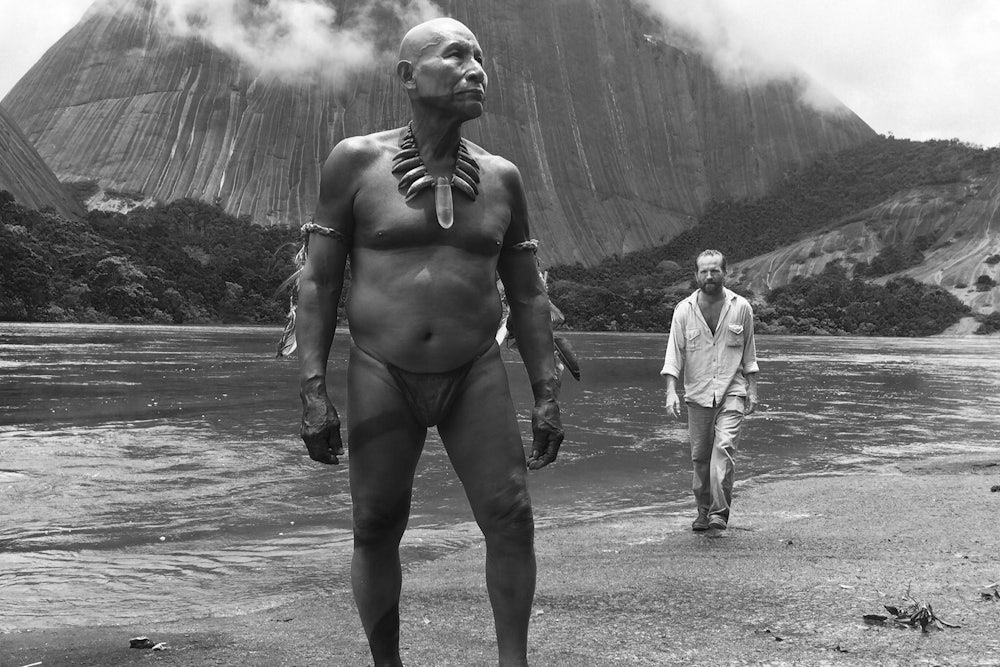The film industry has a long, storied, and particularly clichéd relationship with the Amazon rainforest. One of the most biodiverse and culturally fascinating regions in the world, it nonetheless serves as the setting for only a handful of tired storylines. The jungle is either a verdant mecca for scientists seeking some magical cure and adventurers in search of treasure, or a 1.4 billion-acre thicket of threats including cannibalistic tribes and giant anacondas. No matter the plot—from Cannibal Holocaust to the Werner Herzog 1982 classic, Fitzcarraldo—one constant remains: The protagonist is a Westerner (usually a white man).
Embrace of the Serpent, Colombian filmmaker Ciro Guerra’s third feature and his country’s first-ever nominee for Best Foreign Language Film, does not appear much different on paper. As its title suggests, there are snakes. There are also white explorers in search of a rare plant with curative properties. And there is cannibalism (or the beginnings of it, anyway). But: The snakes aren’t man-eating, just metaphorical; the plant, yakruna, is merely a hallucinogenic; and the attempted cannibalism is ordered by a white man on himself, a self-appointed messiah apparently committing suicide-by-disciple.
Which is to say, Embrace of the Serpent militates against cliché. The film was even shot in black and white, an explicit rejection of the lush, polychromatic cinematography we’ve come to expect from Amazon movies. Far from being a declaration of auteurism (see: Alexander Payne, Noah Baumbach, et al), the dichromatic palette sets the film firmly in the past—one with just a hint of real history, like a brittle old issue of National Geographic come to life.
Embrace of the Serpent was “inspired” by the diaries of two (white) explorers who both searched for yakruna in different eras: German ethnologist Theodor Koch-Grünberg in the early twentieth century, and, decades later, American biologist Richard Evans Schultes. As depicted in the film, both explorers are ill in their own way: “Theo” is physically sick, while “Evan” is metaphysically sick, having never once dreamed in his sleep. For both, yakruna is the supposed cure.
Neither character is the film’s protagonist. It’s Karamakate, a shaman and the last of his tribe, who helps Theo and Evan during different periods of his life (old Karamakate is played by Antonio Bolívar Salvador, who is indeed one of the last of his people, the Ocaina). Karamakate isn’t a stereotypical “noble savage,” though. He condescends to his white companions at least as often as they do to him; as he says to Evan, “You devote your life to plants. That’s the most reasonable thing I’ve ever heard a white say.” And while he’s protective of the rainforest, Karamakate is so distrustful of outsiders that he’d rather watch it burn than let whites exploit it.
Embrace of the Serpent is a corrective of sorts to Fitzcarraldo, heretofore the greatest film about the Amazon. Herzog was accused of exploiting indigenous people on the set, a production whose documentary-worthy troubles mirrored those of the film’s eponymous protagonist, a music-loving Irishman who in a bid to get rich in the rubber business and build an opera house in Iquitos, Peru embarks on a Sisyphean steamboat trip upriver toward the last leasable plot of land. (This includes an epic portage requiring dozens of “natives,” some of whom die in the effort.) Fitzcarraldo, in other words, set out to acculturate a land that Herzog himself called “vile and base, full of obscenity”—a metaphor made clear when Fitzcarraldo, upon hearing the percussive music of an indigenous tribe, blasts opera from an enormous hand-crank gramophone pointed at the shore. The same musical device appears in Embrace of the Serpent, but it is a fraction of the size. Evan plays Haydn’s “The Creation” for Karamakate, who says, “It’s a dream. You must follow it.” Evan dismisses this: “I am a man of science. Of real, palpable facts. I can’t be guided by dreams I don’t have.” The gramophone is no longer a symbol of the superiority of Western culture, but the smallness of the Westerner’s perspective.
That’s the closest Embrace of the Serpent ever comes to lecturing the viewer. Rather than a jeremiad against neocolonialism, the film is—as the tagline on the Colombian poster calls it—“an Amazonian dream.” The historical veneer melts away, and eventually reality itself turns slippery. If this is an old National Geographic come alive, it’s thanks to the influence of a very powerful psychedelic. Speaking of: What becomes of the yakruna? It’s not the only mystery that Guerra is content to leave unresolved. The mysteries keep piling up through the final frames, when black-and-white film can’t contain the story any longer and it bursts with unworldly color. You won’t want to wake up.
For more Oscar coverage, click here.
